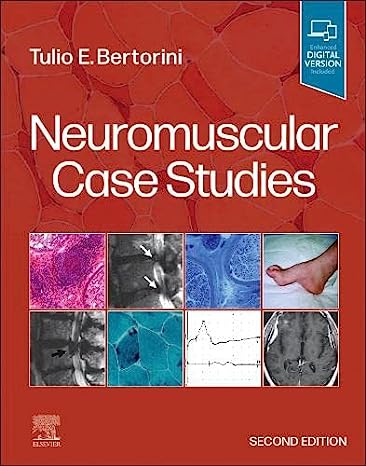
Chapter 1
Anatomy and physiology of the peripheral nervous system.
Chapter 2
Neurological evaluation including history and clinical examination, and diagnostic tests which include electromyography, laboratory studies, histology, genetic testing and imaging.
Chapter 3
Therapies of neuromuscular disorders describe different treatments which include:
01. Painful neuropathies.
02. Dysautonomic neuropathy.
03. Immunotherapy in neuromuscular diseases.
04. Novel genetic therapies
이 책의 특징
Ideal for neurologists and other health care professionals who treat patients with neuromuscular diseases, Neuromuscular Case Studies, 2nd Edition, presents more than 100 cases of both common and rare neuromuscular disorders. Dr. Tulio E. Bertorini provides the latest tools and strategies for diagnosis and management that minimize disability and maximize quality of life for your patients, including up-to-date coverage of numerous recent advances in the field. Using a multidisciplinary approach, this practical text contains two parts: the first includes basic aspects of anatomy, physiology, diagnostic tests, and therapeutic strategies; the second describes specific cases and their diagnosis and management.
Key Features
Presents a multidisciplinary approach to the management and therapeutic treatment of the full range of neuromuscular disorders and resulting complications.
Covers the latest advances in the field, including genetic causes of hereditary diseases, new autoimmune diseases, and promising new therapies such as antisense oligonucleotides, gene therapies, and immunotherapy.
Includes the wide range of disorders that fall under each disease classification (e.g., the Motor Neuron Diseases chapter includes all forms of spinal atrophy, ALS, neuropathies and myopathies, as well as disorders of neuromuscular transmission). In turn, each disease section includes diagnosis and evaluation, treatment, outcome, and suggested readings.
Uses a reader-friendly format that takes you step by step through the diagnosis and treatment of neuromuscular disorders, from the basic anatomy and physiology of the nerve and muscle through to clinical evaluation, diagnostic testing, and therapy.
Reviews the etiologies, pathogenesis, differential diagnosis, and management of each disorder, helping you not only recognize its presentation, but also determine the best treatment plan.
Arranges case studies and indexes both by complaint and by diagnosis.
Features full-color clinical images and diagrams — along with numerous diagnosis tools, tables and treatment algorithms throughout — that make complex concepts easier to understand and apply.
Shares the knowledge and experience of an expert in clinical neuromuscular care.
An eBook version is included with purchase. The eBook allows you to access all of the text, figures and references, with the ability to search, customize your content, make notes and highlights, and have content read aloud.



